Where has the year gone! Well, our Aikido year was fun while it lasted! It has been an eventful year for ASC which started with hosting Masuda Shihan for a whole month; then the mid-year grading; Andrew Sensei was hosted by Club Aikido, Singapore for their grading & seminar in August; Gary & Logan attended Kimori Dojo’s annual seminar in Nagoya; ASC’s Spring Seminar with Yamashima Shihan in September; then Andrew, Irene, Shane & Miria jetted off to Tanabe for the IAF 2008 right after the Spring Seminar; and finally our year end seminar & grading with Takase Shihan followed by the awesome Dawn Training. This year, ASC is proud to have graded 4 Sandans, 6 Nidans, 5 Shodans, 83 Kyu grades, and 109 kids. What a year, eh!
You all deserve a great X’mas break and I’m sure you’ll be looking forward to another great Aiki year ahead.
HAPPY HOLIDAYS!
Editor – Terry Mah
A FEW THOUGHTS…
Last magazine I noted that one of the challenges that we face is to maintain and improve standards
At the start of 2008 the grading syllabus for NZ was changed and minimum training times reduced to bring us more in line with Tokyo Hombu. One of the most significant changes was getting rid of 6th kyu so that the first grade students sit is 5th kyu.
The minimum training times for each grade were also reduced. Under the grading requirements prior to 2008 you were required to attend a minimum of 125 trainings by the time you sat 4th kyu. Now potentially you can sit with a mimumum of 80 sessions.
This reduction of training times was to both bring us in line with Tokyo Hombu grading requirements and to allow those dojos which only train 2 or 3 times per week the ability to grade regularly.
However, in Christchurch we train every day and in fact have over 20 adult sessions per week. Our top training record for one month was set by Kahu in October and was of course 59 sessions. There is thus ample opportunity to accumulate trainings. And simply put, the more you train, the more you learn and the better you will be.
Therefore, to maintain our high standards in Christchurch I expect students will present at grading time with substantially more than the minimum training time. This will go a long way to maintaining & improving the standard. It will require effort from students but aikido is great because it requires patience and effort; which many things in society today do not.
What do you need to do? We have just completed our end of year grading. Set a path now for the next grading [anticipated to be in late June]. I suggest you look at what the minimum required times are for your next grade, double it and work out how many trainings per week you need to achieve that figure. Allowing for sickness and missing a few sessions you will have at least 50% more than the minimum level by next grading. With that sort of number of sessions you will be confident at the grade level, your standard will be high and the instructors will be confident that you will grade well.
Andrew Williamson Sensei
SPECIAL NEWS:
We are privileged that Masuda Shihan has confirmed that he and his wife will be travelling to Christchurch in 2009 arriving on 29 January and leaving on 28 February. We will thus have the opportunity to train again with one of the most senior instructors active in the world. Details about training days etc will be circulated in January but keep February free.
Editor
AN INTERVIEW WITH YAMASHIMA SHIHAN – in his own words

Training with Yamashima Sensei every Friday on the thirty-third floor of the Tokyo Metropolitan building in Shinjuku and every Sunday at his home dojo in Nerima was a good chance to get close to a teacher of the “old school”. Yamashima Sensei began training at Aikido when he and Aikido were still young; when the worldwide popularity that Aikido enjoys nowadays was perhaps only a dream.
Aikido came to his attention by way of his university’s notice-board. He says:
“On a university board, I found a notice that was seeking Aikido club members – then I had a trial lesson, and I got caught by shihonage. At the time, I felt like it was a childhood play. I thought this sport suited me.”
As a resident of Tokyo, it was a simple thing to travel to Hombu Dojo and listen to Morihei Ueshiba’s demonstrations, but it must have been an exhilarating time. After graduating from University, Yamashima Sensei started work and became a regular at Hombu Dojo, where he came to realise an important truth:
“In order to use my whole body effectively, I had to keep my whole body relaxed”
As Yamashima Sensei’s training began to develop and take on the smooth and strong style that is his trademark, he would also make annual pilgrimages to the Aiki Shrine in Iwama, where he came to a second realisation:
“Aikido is not just a time to move your body – it’s a good chance for me to contemplate my spiritual backbone
Today, we train with the knowledge that wherever we go in the world, a friendly Aikido Dojo will be close at hand. For me, that’s a feeling of security that I have to thank the teachers of Yamashima Sensei’s generation for, because their original fire has fanned Aikido across the globe. As Yamashima Sensei explains:
“Of course, it is going to spread out to the world. Aikido is not a competitive sport, but is it great way to improve yourself. As you train Aikido more, you will find more satisfaction. As Morihei Sensei says: ‘Aikido is the way to self realisation’”
I hope everyone enjoys training with Yamashima Sensei.
Geoff Sinha, Yokohama, Japan
IAF 2008, TANABE, JAPAN
What makes aikido ‘fun’? Tales from the IAF, Japan 2008
Who would have thought a trip to Japan to do a martial art would be ‘fun’? If you had told me three years ago that I would return to my ryokan (hotel) happy after a whole day of being flung around a hard mat by large bulky men and strong tough women, I would have laughed. I would have laughed because I wouldn’t have understood what you meant by ‘fun’. Tired, yes. Bruised, yes. Confused, yes. But having ‘fun’ because I could meet scary black belts from all over the world? Having ‘fun’ because watching thousands of black and white aikidokas from above is somehow poignantly beautiful? ‘Fun’ because someone attacks you over and over again? Nope, I really would not have believed you.
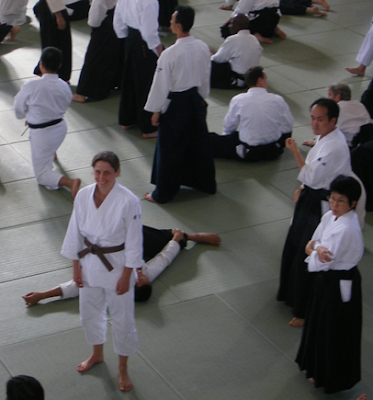
I was lucky enough to travel to Japan in October for the 10th International Aikido Federation Congress, held in Tanabe, where O Sensei was born. Andrew, Irene and Shane were my wonderful travel companions and in large part the ‘fun’ was thanks to them. They will of course have their own versions of this story, but I’d like to share a few things about what the experience meant for me – the Aikido, Japan, and the people.
Aikido
To be honest, I felt rather nervous about going to the IAF – how would a little kiwi brown belt cope in the big wide world of black belts, amazing teachers, and seven full days of training?
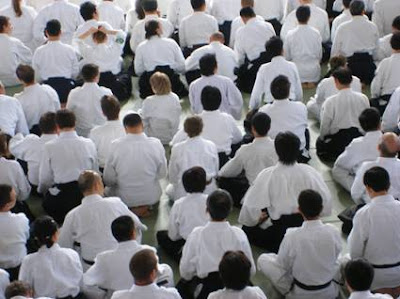
Well I tell you, I smiled when one of the first things a Shihan said was ‘we’re all beginners’. And I could see that all around me, people of all grades and nationalities were as confused about the technique as I was. And somehow, we were all in this together and I think it made most of us feel humble. You’ll have to excuse my use of the phrase ‘one of the shihan’. I was awed by all of them, and can’t remember exactly who said what. But you know what? I don’t think they would mind too much because many of them said the same thing in different ways. The sheer number of people on the mat contributed to the fact that most Shihan focused more on ‘philosophies’ or ‘principles’ of aikido rather than the finer points of techniques. I learned that posture is extremely important. I learned about circles, about my centre, about being flexible, relaxing, about breathing and about etiquette. I learned that we shouldn’t use force, that we should ‘find the lines’ and we should bend our knees. I learned to ask questions; ‘how can I be relaxed when I’m really not feeling relaxed?’ was a common one. As I write this, I realise I learned a lot but they’re not big things – they’re part of my aikido journey. I also realise that I may change my mind about a lot of those things, and that’s ok too.
Japan
I said before that I was lucky to travel to Japan. From the beautiful, serene temple gardens of Kyoto, to the neon lights and organized chaos of Tokyo, I loved all the places we went.
But let me tell you about Tanabe. Located in the Southwest of the Kii Peninsula in Southern Wakayama Prefecture, Tanabe is the birthplace of Ueshiba Morihei; a lovely town surrounded by stunning scenery – both mountains and the beautiful coastline.
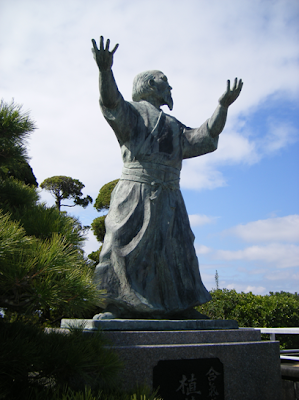
Irene and I only discovered the shops a few days after being there (to Shane and Andrew’s relief), but I think even they enjoyed wandering around the narrow streets saying hello to both locals and other ‘aikido tourists’, admiring the statue of O’ Sensei, visiting local shrines and O’ Sensei’s gravesite, ‘popping in’ to kimono shops, wooden toy shops, sweet shops, and my personal favourite – the restaurants. Salty tempura, deliciously fresh sashimi, sweet fish, and huge plates of noodles, miso and edamame… ahh the memories… washed down with sake and beeru of course. Visiting O’ Sensei’s grave was very special, as was the International Aikido Demonstration held at Oyunohara – Irene and I felt very proud of ‘our men’ as they did their demonstration to represent NZ. They won’t tell you, but they received lots of positive comments. In fact, the whole trip made me realise that we are very lucky to have Andrew and Irene as our teachers, both ‘technically’ and ‘socially’! Of course we’re very lucky to have all our teachers!
The People
And that brings me to the people. The people of Tanabe were amazingly generous and hospitable. We received so many welcomes, smiles, gifts, photos of O’ Sensei, and delicious meals… Being in Tanabe was made special by the locals. It was also fantastic to see and meet the rest of the kiwis there with Takase Shihan, and to be reunited with our New Caledonian friends who, even though they were also tourists, managed to again amaze us with their hospitality.

We were also very happy and lucky to spend time with Sawada Shihan and Fuji Shihan and Aaron (in Tanabe and at their dojo in Nagoya), and with Masuda Shihan, Mrs Masuda and Yamashima Shihan in Tokyo, among many other wonderful people we met – smiles, jokes, food, tours and parties were all a big part of the fun – real fun, without inverted commas! And of course the 1000 other participants at the IAF were great to meet, train with, and talk to. This aikido business connects us to a large number of amazing people and the warm glow I felt amongst new and old friends is still lit within me. I turned a year older while in Japan and I like to think I became a bit wiser too – wiser about the real benefits of stepping (or rolling) outside your comfort zone and coming into contact (that’s upright, flexible yet strong, knees bent contact) with people and cultures that are very different to our own. Try it, its ‘fun’!
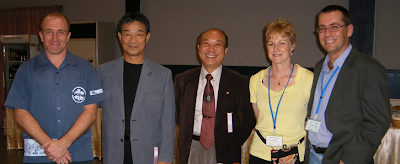
Miria Lange, Christchurch
A Shodan’s Metamorphosis
This was supposed to be a pre-shodan write-up, but the grading has come-and-gone too quickly for me, and now I’m writing from the “other side.” I’ve been training for about a little over 3 years now, and I’ve spent lots of time thinking and talking Aikido, so I’m going to share with you a few things I’ve picked up.
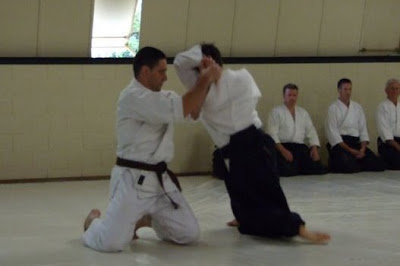
First, thoughts about grading preparation:
- Gradings never go as well as you want (or as movie-like as you imagine), so relax and enjoy the bits that work well.
- Most of the pre-grading stress is self-inflicted, do the proficiency tests, work on your problem techniques, and you should be well prepared.
- You’re not going to improve your techniques much in the two weeks before grading, so spend some time working on your mental strategy (relaxing and focusing) and moving better (your balance and stance).

Second, training in general:
- When you can, train as much as you can. When you can’t, don’t panic.
- You won’t get steadily better the longer you train, you’ll actually get worse before you get better – so don’t panic when nothing is working, something good it just around the corner.
- Don’t get too comfortable – try some different classes, train with people that you find hard to move or throw, and (carefully) try and change your techniques and your ukemi.
- Remember (or pretend) you’re training because it’s fun – it makes it easier to relax.
Finally, if that’s all a bit vague and airy-fairy, here’s the good stuff:
- Do some weapons classes, buy a bokken, and practice your cuts at home – it makes you more efficient.
- Read the book “The Egoscue Method of Health Through Motion” by Pete Egoscue – it’ll help you understand your posture and movement better.
- Maintain your body: practice relaxing, get a deep tissue massage when you can, and see Bruce Crellin (a very handy chiropractic witch doctor).
- Do some morning and advanced classes – you’ll get to train with more yudansha.
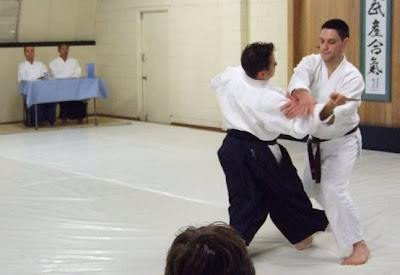
Thanks to everyone over the years who has helped me enjoy aikido and prepare for my grading. Particular mention goes to my ukes on the day, Luciano and Davey Lim, who made me look better than I am; my morning training and coffee partners, Terry, Chris, Peter, and Elissa; the guys that make me think it’s ok to not know what’s going on, Shane, Colin, and Justin. And of course to Andrew and Irene for bringing the club together.
James McNeill, Christchurch
KIDS TO ADULTS CLASS
It was seriously scary. I went from being at the top of the kids class to the bottom of the adults class. I used to be the one that knew most of the techniques to being absolutely clueless (kind of). It felt strange wearing a white belt again and sitting at the end of the row instead of at the beginning. I was afraid that I was going to make a fool out of myself.
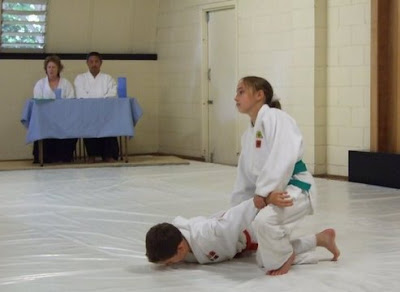
Michelle at Kids Grading
I didn’t make a fool out of myself thankfully. I did feel a bit like an outsider though. It didn’t take long to join in. The class works a lot faster and concentrates more on the techniques compared to the kids classes. You are also surrounded by people that are more focused and that are enthusiastic about training.
The classes are way longer than in the kids class. The adults class has about an extra half an hour than the kids class. This way you have heaps of time to do a good long warm up and brush up on your footwork.
You also learn different ways to do a technique. In the kids class you usually only learn one way and it is a very simple way that isn’t as effective as some of the other, harder ways. In the adults class you learn to do the same technique about two or three different ways. Sometimes more. The way that you think of doing the technique changes too! Normally in the kids class the partner will usually automatically fall over or say it hurts whereas in the adults class you really get to put it on and make them fall over because you want them to and not because they want to.

Michelle at Gokyu Grading
All in all it is a lot more fun in the adults class. A lot more challenging and a lot more encouraging. I really enjoy myself in the adults class.
Michelle Williamson, Christchurch
CLUB AIKIDO, SINGAPORE
A place to Learn, Train and Enjoy Aikido.
September 2003 – a small group of aikido enthusiasts headed by Sensei Koh Nai Sing gathered to train at a courtyard leased from Salvation Army (a charity association) and thus a small neighbourhood aikido club (Club Aikido) was formed in Singapore.
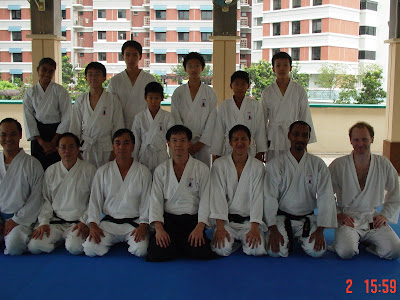
From these humble beginnings, Club Aikido has slowly grown to now 8 dojos all over Singapore, with 2 more upcoming dojos on hold due to a tight time slot.
Sensei Koh started training in the early 1980’s with Aikikai Singapore and was a committee member in the mid 1990’s. He also started conducting classes in the late 1990’s.
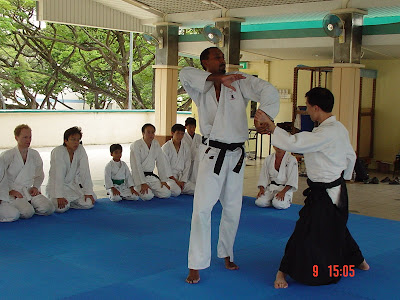
He also assisted in the formation of another aikido group and was there for over a year until it found its footing to run independently.
From the outset, the philosophy of Club Aikido has always been the promotion and learning of Aikido in a fun, healthy and positive environment. The philosophical aspects of the art are as much emphasized as the physical during the training. Trainees are encouraged to practice the principles of sharing, giving and harmonizing with one’s environment at each training session.
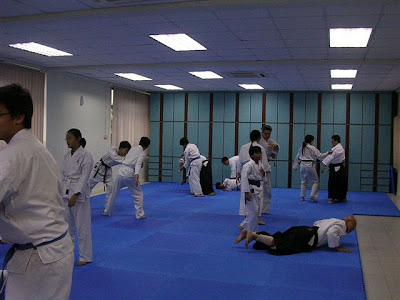
We approached Aikido as self-defense art, a fitness training activity, a self-discovery and self-appreciation training for everyone.
Recently Club Aikido had the honour and opportunity to be associated with Sensei Andrew, Chief Instructor of Aikido Shinryukan, Canterbury, New Zealand, who had during his recent visit shared with us his excellent knowledge and understanding of Aikido.
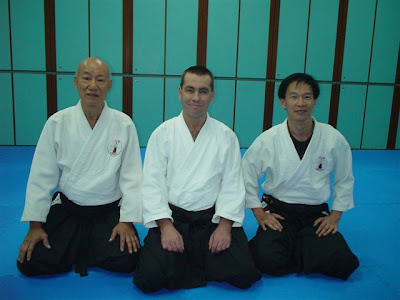
And with his future regular visits and kind guidance, Club Aikido will surely benefit much
with this friendship and generosity extended to us from the distant shores of New Zealand.
Sensei Nai Sing Koh, Club Aikido, Singapore
SOME LIGHTER MOMENTS
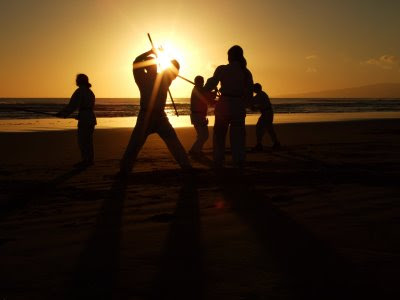
DRAGONBALL Zzzzzzz
(should still be in bed!!)

